“Wisdom is born in fools as well as wise men”.
It was a joy to watch Star Wars: The Clone Wars finally receive the conclusion it deserved with the long-awaited seventh and final season airing on Disney+ earlier this year. But it wasn’t the first time we thought we were watching the final episodes of the animated show. The shock cancellation of the series after its fifth season left multiple story arcs either unaired or unfinished, and so the announcement of ‘The Lost Missions’, a 13-episode season that has since been rebranded as season six, was like a gift from Lucasfilm heaven.
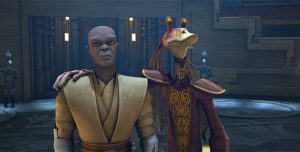 Not knowing of the true final season to come six years later, every morsel of ‘The Lost Missions’ was hungrily picked apart and consumed, with fans hoping each episode offered something substantial. With the unexpected pressure of these regular episodes suddenly becoming the final instalments of the show, a two-parter focused on Jar Jar Binks placed right in the middle of the season was not well received, to put it lightly. But now that the pressure is off the sixth season and the episodes within can be treated like any other from the show, I believe that this Jar Jar two-parter, ‘The Disappeared’, is the hidden gem of The Clone Wars.
Not knowing of the true final season to come six years later, every morsel of ‘The Lost Missions’ was hungrily picked apart and consumed, with fans hoping each episode offered something substantial. With the unexpected pressure of these regular episodes suddenly becoming the final instalments of the show, a two-parter focused on Jar Jar Binks placed right in the middle of the season was not well received, to put it lightly. But now that the pressure is off the sixth season and the episodes within can be treated like any other from the show, I believe that this Jar Jar two-parter, ‘The Disappeared’, is the hidden gem of The Clone Wars.
For the most part, ‘The Lost Missions’ does work quite well as a final season. As the series drew ever closer to Revenge of the Sith – the inescapable endpoint of the show – it began to answer lingering questions and tie up loose ends. For example, the season begins with an arc explaining how Order 66 is possible and we see how close the clones and Jedi came to discovering the truth. The season ends with a fantastic arc detailing the past of the mysterious Sifo-Dyas and how Yoda came to learn how to survive through the Force after his death. It’s easy to see then why a seemingly inconsequential two-parter featuring Jar Jar Binks and his romantic interest seeking the truth behind the disappearance of some force sensitive beings on a distant planet might anger some fans. I too remember disliking the episodes, but on my latest rewatch in preparation for the final season, I came to enjoy ‘The Disappeared’ more than I ever could have imagined.
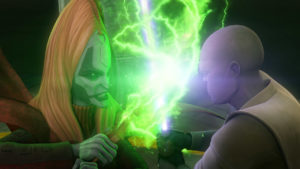 The controversial Gungan isn’t alone on his quest to seek the truth behind the disappearances. Mace Windu accompanies him and this is one of the few times we actually get to explore Mace as a character. Other than Samuel L Jackson’s gravitas and a cool purple lightsaber, Mace is a fairly uninteresting character in the films and the series continues this by simply not giving him anything to do. We’ll occasionally see him in battle but most of his time is spent at the Jedi Temple, sending other Jedi on 22-minute adventures. ‘The Disappeared’ finally gives Mace a place to shine and it doesn’t waste the opportunity. I love when the series explores the flaws of the Jedi, both the Order at large and the individuals that make up its ranks, and Mace is shown to be far from a model Jedi.
The controversial Gungan isn’t alone on his quest to seek the truth behind the disappearances. Mace Windu accompanies him and this is one of the few times we actually get to explore Mace as a character. Other than Samuel L Jackson’s gravitas and a cool purple lightsaber, Mace is a fairly uninteresting character in the films and the series continues this by simply not giving him anything to do. We’ll occasionally see him in battle but most of his time is spent at the Jedi Temple, sending other Jedi on 22-minute adventures. ‘The Disappeared’ finally gives Mace a place to shine and it doesn’t waste the opportunity. I love when the series explores the flaws of the Jedi, both the Order at large and the individuals that make up its ranks, and Mace is shown to be far from a model Jedi.
In Revenge of the Sith, we see that Mace would ignore the Jedi way and sought to execute Palpatine for his evil machinations, an unexpected decision for one of the most powerful and dedicated Jedi in the galaxy. These animated episodes explore Mace’s headspace by placing him in a situation in which he is unwanted. The citizens of Bardotta have a tense history with the Jedi, seeing them as kidnappers who take force-sensitive children away from them, much like the unknown villains are doing once again, and so Mace has to hide his true identity and pose as Representative Binks’ servant. Not only is this conducive to comedy but it also puts Mace into a position in which we can see just how petulant and impatient he can be, with him leaning on traits more common with the dark side. In these episodes, Windu acts as a perfect personification of the flawed Jedi Order at this point in time and his actions often makes situations worse as he ignores Jedi teachings in favour of a querulous disposition.
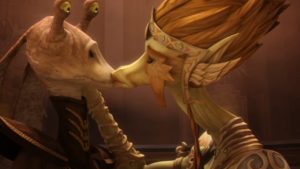 But if any character is going to test the patience of a Jedi it’s Jar Jar Binks. While the Gungan began the series much like the contentious movie version of his character, his final episodes present a much-improved Jar Jar. While I’ve never hated the character, sometimes his goofiness is too much even for me, but ‘The Disappeared’ is the best he’s ever been. The romance he has with Queen Julia (not a Star Wars-y name) is shockingly charming; he does his job as a senate representative well (much better than how Mace performs in his role as a Jedi); and he’s genuinely funny. I know, that’s impossible but it’s true. Jar Jar actually made me laugh in this episode, just like he did in season four’s ‘Shadow Warrior’. The comedy surrounding the character has drastically improved, and while there are still some bad moments, there’s more good ones than ever before. And, if you do hate the character, you see him get slapped in the face, so there’s that too.
But if any character is going to test the patience of a Jedi it’s Jar Jar Binks. While the Gungan began the series much like the contentious movie version of his character, his final episodes present a much-improved Jar Jar. While I’ve never hated the character, sometimes his goofiness is too much even for me, but ‘The Disappeared’ is the best he’s ever been. The romance he has with Queen Julia (not a Star Wars-y name) is shockingly charming; he does his job as a senate representative well (much better than how Mace performs in his role as a Jedi); and he’s genuinely funny. I know, that’s impossible but it’s true. Jar Jar actually made me laugh in this episode, just like he did in season four’s ‘Shadow Warrior’. The comedy surrounding the character has drastically improved, and while there are still some bad moments, there’s more good ones than ever before. And, if you do hate the character, you see him get slapped in the face, so there’s that too.
The pairing of Windu and Binks (the best cop show never made) is the perfect odd couple, matching the most serious and dour of all the Jedi with the clumsiest and goofiest character in the entire franchise. Without the pressure of being viewed as one of the final episodes of the series, ‘The Disappeared’ is just great fun and I wish we got to see these characters interact more often. While Jar Jar begins the two-parter with his usual display of killing enemies in an accidental fashion, he ends it by proving himself a good warrior, grabbing a huge blaster from an enemy and using it to dispatch goons on his quest to save his love. The two come to rely on each other in the second part, with Jar Jar using his tongue to grab and throw Mace’s lightsaber to the Jedi in a time of need, forcing Windu to look on the Gungan, and all beings he once saw as lesser than him, with fresh eyes.
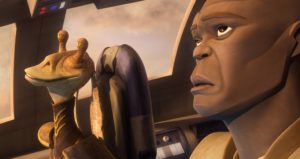 It’s with characters like Mace and Jar Jar that The Clone Wars can do some of its best work. Many of the core protagonists of the series – such as Anakin and Obi-Wan – have the true exploration and culmination of their character arcs in the films, and the series can only fill in the blanks and move them slowly to a point where their actions in the movies make logical sense. Windu and Binks are characters untouched by finer details in the films and so the series can build them up and explore them more than the primary characters. Not as much as characters created specifically for the series – Dave Filoni has said he sees The Clone Wars as Ahsoka and Rex’s story – but enough to transcend them from being more than just the goofy CGI character and that Jedi with the purple lightsaber. It’s with episodes like ‘The Disappeared’ that the series does its best job at expanding the prequel era and the characters therein.
It’s with characters like Mace and Jar Jar that The Clone Wars can do some of its best work. Many of the core protagonists of the series – such as Anakin and Obi-Wan – have the true exploration and culmination of their character arcs in the films, and the series can only fill in the blanks and move them slowly to a point where their actions in the movies make logical sense. Windu and Binks are characters untouched by finer details in the films and so the series can build them up and explore them more than the primary characters. Not as much as characters created specifically for the series – Dave Filoni has said he sees The Clone Wars as Ahsoka and Rex’s story – but enough to transcend them from being more than just the goofy CGI character and that Jedi with the purple lightsaber. It’s with episodes like ‘The Disappeared’ that the series does its best job at expanding the prequel era and the characters therein.
While it may not seem like it at first, the two-parter does eventually tie into some of the wider serialised storytelling of the series, with the reveal that Mother Talzin is behind the disappearances. The Nightsister Mother is leading a cult who kidnap force sensitive beings so she can extract their power to regain the abilities she lost when Grievous attacked Dathomir. I’m always excited by any chance to see Nightsister magik on display and learn more about Talzin, who remains one of the most mysterious characters in the franchise. We even get a brief duel between her and Mace, his purple lightsaber clashing against her magik weapon conjured from nowhere. And yes, a big part of my enjoyment of ‘The Disappeared’ is that we get to see Mace’s purple lightsaber in action multiple times. Ever since he revealed it on Geonosis in Attack of the Clones, I’ve been obsessed with the blade, and I leap at the chance to use one just like it in video games, such as last years’ Jedi: Fallen Order.
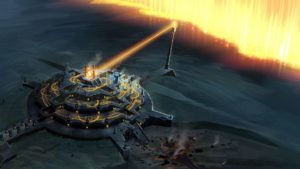 The episodes not only do a great job of capturing the spirit of Star Wars but also a fellow Lucasfilm property: Indiana Jones. ‘The Disappeared’ is one big homage, including a chase through a market feeling very similar to the basket chase featured in Raiders of the Lost Ark, now with added Gundarks and E-Webs. The ceremony at the end of the episode is inspired by the one at the end of the aforementioned film, and even prominently features a lens directing the sun’s rays to a particular spot. Kingdom of the Crystal Skull gets some love in the form of the Bardotta throne room being based on the one seating the inter-dimensional aliens in the film. But the episode takes most of its inspiration from Temple of Doom, my favourite of the series. The entire ending of the first episode is set in a demonic cult’s underground temple that is surrounded by lava, with the prisoners being held in cages that drop into the fiery abyss. Sadly however, the episodes have also copied the film’s casual racism with the aliens having truly terrible Indian accents, bringing to mind unfavorable comparisons with Short Circuit.
The episodes not only do a great job of capturing the spirit of Star Wars but also a fellow Lucasfilm property: Indiana Jones. ‘The Disappeared’ is one big homage, including a chase through a market feeling very similar to the basket chase featured in Raiders of the Lost Ark, now with added Gundarks and E-Webs. The ceremony at the end of the episode is inspired by the one at the end of the aforementioned film, and even prominently features a lens directing the sun’s rays to a particular spot. Kingdom of the Crystal Skull gets some love in the form of the Bardotta throne room being based on the one seating the inter-dimensional aliens in the film. But the episode takes most of its inspiration from Temple of Doom, my favourite of the series. The entire ending of the first episode is set in a demonic cult’s underground temple that is surrounded by lava, with the prisoners being held in cages that drop into the fiery abyss. Sadly however, the episodes have also copied the film’s casual racism with the aliens having truly terrible Indian accents, bringing to mind unfavorable comparisons with Short Circuit.
‘The Disappeared’ is often unwarrantedly derided. Yeah, it’s an episode starring Jar Jar Binks and in what was once the final season of the show, that’s a disappointment. But the series has come a long way from the episodes focusing on Representative Binks in the first season, just like every aspect of the series has evolved. His pairing with Mace makes for a fun and charming adventure – what Star Wars should be at its core – and it develops these somewhat lacklustre characters with aplomb, while also paying homage to another much loved Lucasfilm franchise and adding an unexpected extra kink to the serialised arc that came to dominate the series. I hope now that the actual final season of The Clone Wars has aired, fans can revisit this sixth season effort and see it as the hidden gem it truly is.
What are your thoughts on ‘The Disappeared’? What do you consider to be the hidden gem of Star Wars: The Clone Wars? Let me know in the comments and be sure to geek out with me about TV, movies and video-games on Twitter @kylebrrtt.




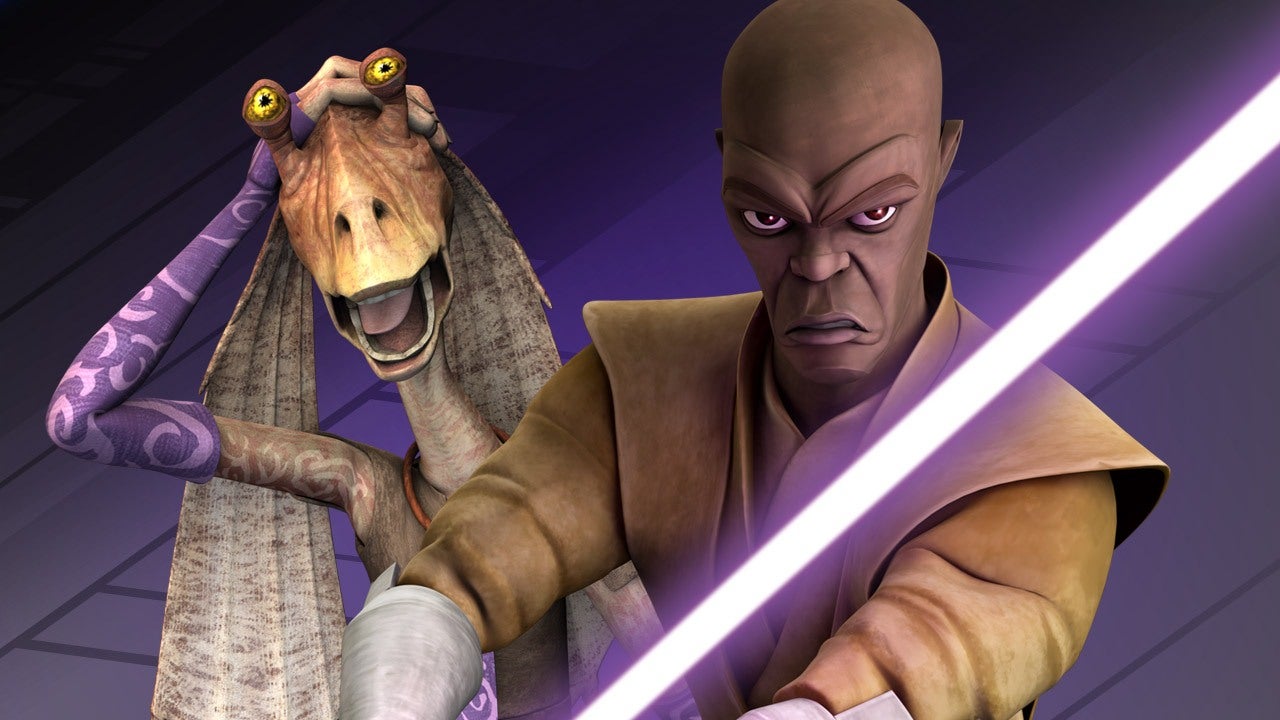
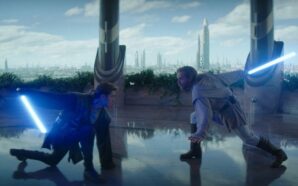

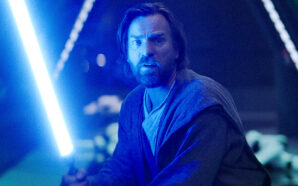
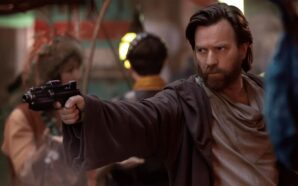
I realize I’m 3 years late finding this article, but that doesn’t change the fact that it’s super well-written and positive, but appropriately critical. This may be the best Star Wars opinion piece/review I’ve ever read. Kudos Kyle, I’ll be looking for more from you. Two thumbs up!